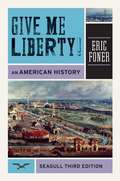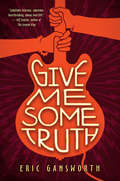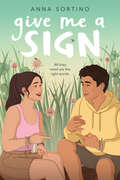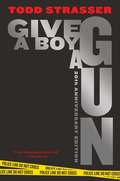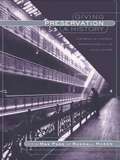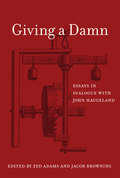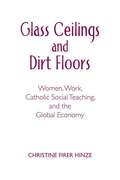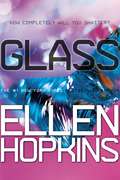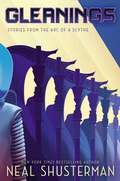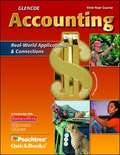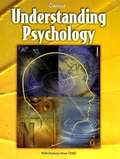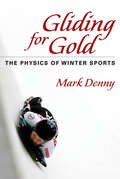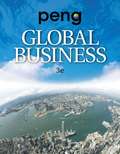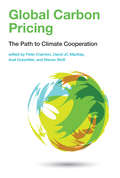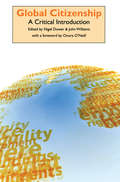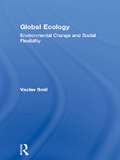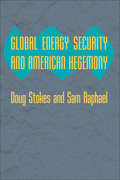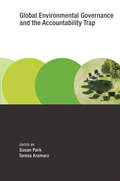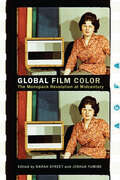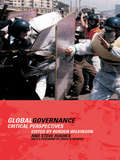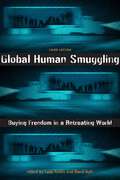- Table View
- List View
Give Me Liberty! An American History Volume One (Seagull, 3rd Edition)
by Eric FonerDesigned as a textbook for high school students taking the Advanced Placement test in history, this comprehensive history of the United States would be suitable for regular high school and freshman college US history survey courses. This is the third edition; earlier editions have been widely used in two- and four-year colleges as well as high schools. The text is written in clear, uncomplicated prose that will be easy for general high school students to understand. The book is strong in economic history. The coverage of US history provides excellent depth for a general survey. It avoids the politically-motivated deletions of information that have marred many recent K-12 textbooks in the US. When speaking of painful historical realities such as slavery or smallpox, the author adopts neutral and quiet language in the main text to help readers understand the various perspectives of the time, and allows specific, accurate historical data given in inset texts to speak for themselves about the magnitude of suffering. The book uses a contemporary tone when speaking of the politics of the past, without historicism or gimmicks; readers are alerted to the election of President Polk or the votes-for-women question as fresh news and a live issue for people of that time, exactly as our elections and issues are now. The book offers detail on recent history, ending with the Obama election. It begins with a helpful overview of both North America and Europe just before the start of US history, which gives context for early US history and the contemporary meanings of Constitutional terms like "citizen" and "liberties," which are often quite different from our own. The book is clearly organized, and well illustrated with modern maps and images from the era under study. A short section at the beginning provides an orientation to the AP history exam. Within the book, each chapter begins with a timeline and ends with a bibliography of suggested reading and websites, review questions and essay questions, key terms, and a review table. Appendices include a variety of important documents such as the Constitution, as well as tables and figures, a glossary, and an index. Annotation ©2012 Book News, Inc. , Portland, OR (booknews. com)
Give Me Some Truth
by Eric GansworthA powerful new book from Eric Gansworth, author of If I Ever Get Out of Here, that speaks the truth on race, relationships, and rock from two unforgettable perspectives.Carson Mastick is entering his senior year of high school and desperate to make his mark, on the reservation and off. A rock band -- and winning Battle of the Bands -- is his best shot. But things keep getting in the way. Small matters like the lack of an actual band, or his brother getting shot by the racist owner of a local restaurant.Maggi Bokoni has just moved back to the reservation with her family. She's dying to stop making the same traditional artwork her family sells to tourists (conceptual stuff is cooler), stop feeling out of place in her new (old) home, and stop being treated like a child. She might like to fall in love for the first time too.Carson and Maggi -- along with their friend Lewis -- will navigate loud protests, even louder music, and first love in this stirring novel about coming together in a world defined by difference.
Give Me a Sign
by Anna SortinoJenny Han meets CODA in this big-hearted YA debut about first love and Deaf pride at a summer camp.Lilah is stuck in the middle. At least, that&’s what having a hearing loss seems like sometimes—when you don&’t feel &“deaf enough&” to identify as Deaf or hearing enough to meet the world&’s expectations. But this summer, Lilah is ready for a change.When Lilah becomes a counselor at a summer camp for the deaf and blind, her plan is to brush up on her ASL. Once there, she also finds a community. There are cute British lifeguards who break hearts but not rules, a YouTuber who&’s just a bit desperate for clout, the campers Lilah&’s responsible for (and overwhelmed by)—and then there&’s Isaac, the dreamy Deaf counselor who volunteers to help Lilah with her signing.Romance was never on the agenda, and Lilah&’s not positive Isaac likes her that way. But all signs seem to point to love. Unless she&’s reading them wrong? One thing&’s for sure: Lilah wanted change, and things here . . . they're certainly different than what she&’s used to.
Give a Boy a Gun: 20th Anniversary Edition
by Todd StrasserTodd Strasser’s acclaimed account of school violence that Kirkus Reviews calls “vivid, distressing, and all too real.”For as long as they can remember, Brendan and Gary have been mercilessly teased and harassed by the jocks who rule Middletown High. But not anymore. Stealing a small arsenal of guns from a neighbor, they take their classmates hostage at a school dance. In the panic of this desperate situation, it soon becomes clear that only one thing matters to Bendan and Gary: revenge.
Giver of Life: The Holy Spirit in Orthodox Tradition
by John OliverPresents the Orthodox perspective on who the Holy Spirit is, where the mystery of God comes alive. Delving deep and subtly into Orthodox tradition and theology, Giver of Life articulates the identity of the Holy Spirit as the third Person of the Trinity as well as the role of the Holy Spirit in the salvation of the world. Written with a poetic sensibility, Fr. Oliver begins with Pentecost, an event uniquely celebrated in Orthodoxy as a time when greenery of all kinds is brought into churches. "The splash of green foliage calls to mind not just life, but a special kind of life. It is the life that transcends biological existence and flows from the very Godhead Itself; it is life that's a state of being—immortal, everlasting, changeless. Ferns and flowers fade and die, but souls filled with this 'life from above' flourish forever."Reflecting on the relationship of the Holy Spirit to the Church, to the world, and to the human person, Giver of Life looks to the impressive biblical and liturgical tradition of Orthodox Christianity. This is a book weighty in content but accessible in tone, not an academic study of the mind, but a lived experience of the heart.
Giving Preservation a History
by Randall Mason Max PageIn this volume, some of the best figures in the field have come together to write on preservation movements across the country, from New York to Atlanta to Santa Fe and others. Giving Preservation a History also touches on the European roots of the historic preservation movement; on how preservation movements have taken a leading role in shaping American urban space and urban development; how historic preservation battles have reflected broader social forces; and what the changing nature of historic preservation means for the effort to preserve the nation's past.
Giving a Damn: Essays in Dialogue with John Haugeland (The\mit Press Ser.)
by Jacob Browning Zed AdamsA collection of essays that use John Haugeland's work on intentionality, embodiment, objectivity, and caring to explore contemporary issues in philosophy of mind.In his work, the philosopher John Haugeland (1945–2010) proposed a radical expansion of philosophy's conceptual toolkit, calling for a wider range of resources for understanding the mind, the world, and how they relate. Haugeland argued that “giving a damn” is essential for having a mind—suggesting that traditional approaches to cognitive science mistakenly overlook the relevance of caring to the understanding of mindedness. Haugeland's determination to expand philosophy's array of concepts led him to write on a wide variety of subjects that may seem unrelated—from topics in cognitive science and philosophy of mind to examinations of such figures as Martin Heidegger and Thomas Kuhn. Haugeland's two books with the MIT Press, Artificial Intelligence and Mind Design, show the range of his interests.This book offers a collection of essays in conversation with Haugeland's work. The essays, by prominent scholars, extend Haugeland's work on a range of contemporary topics in philosophy of mind—from questions about intentionality to issues concerning objectivity and truth to the work of Heidegger. Giving a Damn also includes a previously unpublished paper by Haugeland, “Two Dogmas of Rationalism,” as well as critical responses to it. Finally, an appendix offers Haugeland's outline of Kant's "Transcendental Deduction of the Categories.” ContributorsZed Adams, William Blattner, Jacob Browning, Steven Crowell, John Haugeland, Bennett W. Helm, Rebecca Kukla, John Kulvicki, Mark Lance, Danielle Macbeth, Chauncey Maher, John McDowell, Joseph Rouse
Glass Ceilings And Dirt Floors: Women, Work, And The Global Economy
by Christine Firer HinzeToday's market economy depends upon, yet undervalues, the essential contributions of households to the care work that makes all other work possible. As designated tenders of the care economy, women take daily, costly responsibility for a fundamental fact that mainstream economics underplays or conceals, market economy depends continuously on another economy, wherein our embodied vulnerabilities are respected and addressed by way of caring labor and relationships. In this compelling expose on the (in)justice of women's work, Christine Firer Hinze argues for re-prioritizing the holistic understanding of economy as oikonomia-literally, the management of a household in order to sustainably provide for all members-assumed in traditional classical, and contemporary political economics. This oikos-focused paradigm addresses global work-family struggles at their roots by shifting the axis of our economic imaginations, values, and policy making from a marketized-competitive model to one that prioritizes economy's inclusive, provisioning purposes. Following several years of working in inner-city ministry and teaching high school in Detroit, Christine Firer Hinze received a PhD in Christian social ethics from the University of Chicago Divinity School. Her research and teaching focus on Catholic social and economic ethics, women and work, and power and social transformation. Book jacket.
Glass: Your Favorite Authors On Ellen Hopkins' Crank And Glass (The Crank Trilogy #2)
by Ellen HopkinsCrank. Glass. Ice. Crystal. Whatever you call it, it's all the same: a monster. And once it's got hold of you, this monster will never let you go.Kristina thinks she can control the urge, the addiction, the monster trying to drag her down. Now with a baby to care for, she's determined to be the one deciding when and how much, the one calling the shots. But the monster is too strong, and before she knows it, Kristina is back in its grips. She needs the monster to keep going, to face the pressures of day-to-day life. She needs it to feel alive. Once again the monster takes over Kristina's life and she will do anything for it, including giving up the one person who gives her the unconditional love she craves—her baby. A vivid portrait of a victim to addiction, this sequel to Crank is the continuing story of Kristina and her descent back to hell. Told in verse, it's a harrowing and disturbing look at addiction and the damage that it inflicts.
Gleanings: Stories from the Arc of a Scythe (Arc of a Scythe)
by Neal ShustermanThe New York Times bestselling Arc of the Scythe series continues with &“captivating…thrilling&” (School Library Journal) stories that span the timeline. Storylines continue. Origin stories are revealed. And new Scythes emerge!There are still countless tales of the Scythedom to tell. Centuries passed between the Thunderhead cradling humanity and Scythe Goddard trying to turn it upside down. For years, humans lived in a world without hunger, disease, or death with Scythes as the living instruments of population control. Neal Shusterman—along with collaborators David Yoon, Jarrod Shusterman, Sofía Lapuente, Michael H. Payne, Michelle Knowlden, and Joelle Shusterman—returns to the world throughout the timeline of the Arc of a Scythe series. Discover secrets and histories of characters you&’ve followed for three volumes and meet new heroes, new foes, and some figures in between. Gleanings shows just how expansive, terrifying, and thrilling the world that began with the Printz Honor–winning Scythe truly is.
Glencoe Accounting: Real-world Applications and Connections
by Robert Turner Donald Guerrieri F. Haber William HoytGlencoe Accounting: Real World Applications and Connections - First Year Course is the only accounting program with Peachtree fully integrated throughout. Glencoe is the only publisher to use real-world accounting software and companies to teach accounting!
Glencoe Mechanical Drawing: Board and CAD Techniques
by Glencoe McGraw-Hill StaffProject-based learning prepares students for professional certification with Glencoe Mechanical Drawing: Board and CAD Techniques! Endorsed by the American Design Drafting Association (ADDA), this text includes Prep for ADDA activities. Step-by-step applications, design problems, and drafting problems prepare students for professional excellence and certification. Project-based learning is supported with unit-based projects that integrate technical math and culminate in Build Your Portfolio activities. Help your students get ready for competitive events like the TSA and SkillsUSA with prep activities embedded throughout the content and end-of-chapter assessments. Rigorous academic content is supported, with a special emphasis on math, geometry, and science, with STEM activities. Point-of-use correlations ease possible academic credit application. Extra activities in the Student Edition and workbook help you meet Perkins mandates. The appendix features Math (including algebra and geometry), abbreviations and symbols, pipe symbols, and reference tables (ASME, ANSI, ISO).
Glencoe Understanding Psychology
by Glencoe Mcgraw-HillGlencoe Understanding Psychology contains unit lessons on Approaches to Psychology, The Life Span, The Workings of Mind and Body, Learning and Cognitive Processes, Personality and Individuality, Adjustment and Breakdown, and Social Psychology.
Gliding for Gold: The Physics of Winter Sports
by Mark DennyAs anyone from cold climates knows, living with lots of ice and snow can lead to a special appreciation of sports such as skiing, sledding, and skating. Prolific physics popularizer Mark Denny’s take on winter athletics lays out the physical principles that govern glaciated game play.After discussing the physical properties of ice and snow and describing the physics behind sliding friction and aerodynamic drag, Denny applies these concepts to such sports as bobsledding, snowboarding, and curling. He explains why clap skates would only hinder hockey players, how a curling rock curls, the forces that control luge speed, and how steering differs from skiing to snowboarding. With characteristic accuracy and a touch of wit, Denny provides fans, competitors, and coaches with handy, applicable insights into the games they love. The separate section of technical notes offers an original and mathematically rigorous exploration of the key aspects of winter sports physics. A physics-driven exploration of sports played on ice and snow that is truly fun and informative, Gliding for Gold is the perfect primer for understanding the science behind cold weather athletics.
Global Business 3rd Edition
by Mike W. PengThis edition blends both an institutional-based view and resource-based view throughout every chapter for an unparalleled continuity in the learning process. The book combines an inviting, conversational style with the latest research and examples throughout every chapter. A comprehensive set of cases from Mike Peng and other respected international experts examine how companies throughout the world have expanded globally. All-new video cases, world maps, and unique global debate sections help readers view business challenges from a truly global perspective.
Global Carbon Pricing: The Path to Climate Cooperation (The\mit Press Ser.)
by Peter Cramton Axel Ockenfels David MacKay Steven StoftWhy the traditional “pledge and review” climate agreements have failed, and how carbon pricing, based on trust and reciprocity, could succeed.After twenty-five years of failure, climate negotiations continue to use a “pledge and review” approach: countries pledge (almost anything), subject to (unenforced) review. This approach ignores everything we know about human cooperation. In this book, leading economists describe an alternate model for climate agreements, drawing on the work of the late Nobel laureate Elinor Ostrom and others. They show that a “common commitment” scheme is more effective than an “individual commitment” scheme; the latter depends on altruism while the former involves reciprocity (“we will if you will”).The contributors propose that global carbon pricing is the best candidate for a reciprocal common commitment in climate negotiations. Each country would commit to placing charges on carbon emissions sufficient to match an agreed global price formula. The contributors show that carbon pricing would facilitate negotiations and enforcement, improve efficiency and flexibility, and make other climate policies more effective. Additionally, they analyze the failings of the 2015 Paris climate conference.ContributorsRichard N. Cooper, Peter Cramton, Ottmar Edenhofer, Christian Gollier, Éloi Laurent, David JC MacKay, William Nordhaus, Axel Ockenfels, Joseph E. Stiglitz, Steven Stoft, Jean Tirole, Martin L. Weitzman
Global Citizenship: A Critical Introduction (Edinburgh University Press Ser.)
by John Williams Nigel DowerThe idea of global citizenship is that human beings are "citizens of the world." Whether or not we are global citizens is a topic of great dispute, however those who take part in the debate agree that a global citizen is a member of the wider community of humanity, the world, or a similar whole which is wider than that of a nation-state or other political community of which we are normally thought to be citizens. Through four main sections, the contributors to Global Citizenship discuss global challenges and attempt to define the ways in which globalization is changing the world in which we live. Offering a breadth of coverage to the core rheme of the individual in a global world, Global Citizenship combines two factors-the idea of global responsibility and the development of institutional structures through which this responsibility can be exercised.
Global Climate Policy: Actors, Concepts, and Enduring Challenges (Global Environmental Accord: Strategies for Sustainability and Institutional Innovation)
by Urs Luterbacher Detlef F. SprinzAnalyses of the international climate change regime consider the challenges of maintaining current structures and the possibilities for creating new forms of international cooperation.The current international climate change regime has a long history, and it is likely that its evolution will continue, despite such recent setbacks as the decision by President Donald Trump to withdraw the United States from the Paris Agreement of 2015. Indeed, the U.S. withdrawal may spur efforts by other members of the international community to strengthen the Paris accord on their own. This volume offers an original contribution to the study of the international political context of climate change over the last three decades, with fresh analyses of the current international climate change regime that consider both the challenges of maintaining current structures and the possibilities for creating new forms of international cooperation.The contributors are leading experts with both academic and policy experience; some are advisors to governments and the Climate Secretariat itself. Their contributions combine substantive evidence with methodological rigor. They discuss such topics as the evolution of the architecture of the climate change regime; different theoretical perspectives; game-theoretical and computer simulation approaches to modeling outcomes and assessing agreements; coordination with other legal regimes; non-state actors; developing and emerging countries; implementation, compliance, and effectiveness of agreements; and the challenges of climate change mitigation after the Paris Agreement.ContributorsMichaël Aklin, Guri Bang, Daniel Bodansky, Thierry Bréchet, Lars Brückner, Frank Grundig, Jon Hovi, Yasuko Kameyama, Urs Luterbacher, Axel Michaelowa, Katharina Michaelowa, Carla Norrlof, Matthew Paterson, Lavanya Rajamani, Tora Skodvin, Detlef F. Sprinz, Arild Underdal, Jorge E. Viñuales, Hugh Ward
Global Ecology: Environmental Change and Social Flexibility
by Vaclav SmilThe magnitude and rapidity of global environmental change threatens the perpetuation of life on Earth. Many aspects of this crisis are familiar to us - the destruction of tropical rainforests, the hole in the Antarctic ozone, desertification, soil erosion - yet we avoid the underlying challenge of a rapidly deteriorating ecological system and the breadth and complexity of responses demanded. Integrating an analysis of both social and environmental needs, the book explores the premises and problems of different paths towards global management. With its emphasis on flexible response, Global Ecology furthers our understanding of biospheric change and of our abilities and weaknesses in managing the transition to a sustainable society.
Global Energy Security and American Hegemony (Themes in Global Social Change)
by Doug Stokes Sam RaphaelThis analysis of the United States and energy security examines the close relationship between US military supremacy in oil-rich regions and America's maintenance of global power.Energy security generally evokes thoughts of American intervention in the Middle East to protect US interests in that region's oil-rich fields. Doug Stokes and Sam Raphael move beyond that framework to consider US actions in Latin America, Central Asia, and Africa. Drawing on State and Defense Department records and other primary sources and previous scholarship, they show how US foreign policy since World War II has sought to maintain a global energy security regime that supports the nation's allies while maintaining American hegemony. Stokes and Raphael explain how US intervention in energy-rich states insulates and stabilizes those nations' transnationally oriented actors and political economies and why American oil diversification strategy strengthens the country's position against rivals in the global capitalist system. They argue that counterinsurgency aid and other types of coercive US statecraft protect the recipient states from an array of potentially revolutionary armed and unarmed internal social forces, thereby securing the energy supplies of nations deemed strategically important to the United States or its allies. Clear and accessible, this cutting-edge contemporary policy analysis will engage scholars of US foreign policy and international relations as well as policymakers grappling with the importance of energy security in today's world.
Global Environment of Business
by J. Michael Geringer Michael S. Minor Jeanne M. McnettGlobal Environment of Business; Covers the following topics; The Challenging World of International Business International Trade and Investment Labor Forces International Competitive Strategy Marketing Internationally Global Operations and Supply Chain Management
Global Environmental Governance and the Accountability Trap (Earth System Governance)
by Susan Park Teresa KramarzAn examination of whether accountability mechanisms in global environmental governance that focus on monitoring and enforcement necessarily lead to better governance and better environmental outcomes. The rapid development of global environmental governance has been accompanied by questions of accountability. Efforts to address what has been called “a culture of unaccountability” include greater transparency, public justification for governance decisions, and the establishment of monitoring and enforcement procedures. And yet, as this volume shows, these can lead to an “accountability trap”—a focus on accountability measures rather than improved environmental outcomes. Through analyses and case studies, the contributors consider how accountability is being used within global environmental governance and if the proliferation of accountability tools enables governance to better address global environmental deterioration. Examining public, private, voluntary, and hybrid types of global environmental governance, the volume shows that the different governance goals of the various actors shape the accompanying accountability processes. These goals—from serving constituents to reaping economic benefits—determine to whom and for what the actors must account. After laying out a theoretical framework for its analyses, the book addresses governance in the key areas of climate change, biodiversity, fisheries, and trade and global value chains. The contributors find that normative biases shape accountability processes, and they explore the potential of feedback mechanisms between institutions and accountability rules for enabling better governance and better environmental outcomes. Contributors Graeme Auld, Harro van Asselt, Cristina Balboa, Lieke Brouwer, Lorraine Elliott, Lars H. Gulbrandsen, Aarti Gupta, Teresa Kramarz, Susan Park, Philipp Pattberg, William H. Schaedla, Hamish van der Ven, Oscar Widerberg
Global Film Color: The Monopack Revolution at Midcentury
by William Carroll Joshua Yumibe Philip Cavendish Kathryn Millard Sarah Street Laura Major Ranjani Mazumdar Stefan Soloman Kirsty Sinclair Dootson Kamalika Sanyal Heather Heckman Lydia Pappas Elena Gipponi Rafael de Luna Freire Josephine Diecke Linda Chen ZhangGlobal Film Color: The Monopack Revolution at Midcentury explores color filmmaking in a variety of countries and regions including India, China, Japan, and Russia, and across Europe and Africa. Most previous accounts of color film have concentrated on early 20th century color processes and Technicolor. Far less is known about the introduction and application of color technologies in the period from the mid-1940s to the 1980s, when photochemical, “monopack” color stocks came to dominate global film markets. As Eastmancolor, Agfacolor, Fujicolor and other film stocks became broadly available and affordable, national film industries increasingly converted to color, transforming the look and feel of global cinema. Covering a broad range of perspectives, the chapters explore themes such as transnational flows, knowledge exchange and transfer, the cyclical and asymmetrical circulation of technology in a global context, as well as the accompanying transformation of color film aesthetics in the postwar decades.
Global Governance: Critical Perspectives
by Steve Hughes Rorden WilkinsonIn recent years, the role of global institutions such as the United Nations, World Trade Organization, International Monetary Fund and the World Bank has never been more important to the lives of individuals throughout the world. This edited book provides critical perspectives on the role of these institutions and how they use their policies, procedures and practices to manage global political, socio-economic, legal and environmental affairs. In contrast to previously published books on this subject, Global Governance is organized thematically rather than by institution. Each chapter examines core issues such as labour, finance, the environment, health, culture, gender, civil society, poverty and development. It should be essential reading for undergraduate students of international politics, international political economy and international economics.
